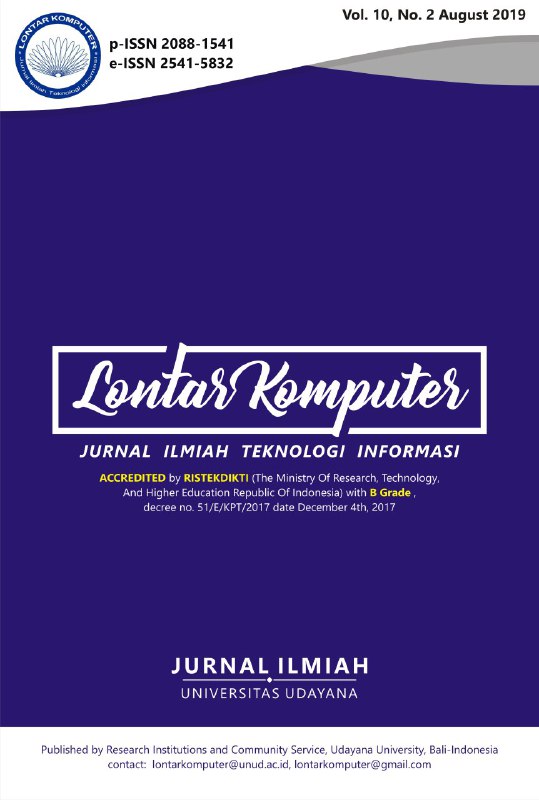Road Quality Assessment Using International Roughness Index Method and Accelerometer on Android
Abstract
The quality of road conditions can determine comfort in driving. To find out the condition of a road whether it has good surface quality, it can use an accelerometer sensor contained in an android smartphone. This research uses the International Roughness Index (IRI) method combined with the accelerometer sensor and the Global Positioning System (GPS). Application of the results of this study can be used to facilitate the contractor maker and road repair, so they can find out which points need to be repaired. Testing is done using two different vehicles, car and motorcycle. Smartphones with road quality detection applications are attached to the car and motorcycle vehicles using a phone holder. This is to record vibration that occurs while the vehicle is moving based on road conditions. The vibration recording results are then validated in a visual observation to determine the accuracy of the assessment results. Based on the test results the level of accuracy on the car is 90% and the motorcycle is 30%.
Downloads
References
[2] F. Suwarto and A. Nugroho, “Audit Keselamatan Jalan Sebagai Dasar Implementasi Perencanaan Karakteristik jalan” Jurnal Proyek Teknik Sipil, vol. 2 no. 1, pp. 22, 2019.
[3] Mahajan and D. V, “Estimation of Road Roughness Condition by Using Sensors in Smartphone” International Journal of Computer Engineering and Technology, vol. 6, no. 7, p. 9, 2015.
[4] Harshgandha, P. Matale, N. Bidgar and SnehaKatkade, “Roadside Quality And Ghat Complexity Analysis”, International Journal of Advanced Information and Communication Technology, vol. 1, no. 11, pp. 5, 2015.
[5] S. A. Arhin, L.N. Williams, A. Ribbiosi and M. F. Anderson. “Predicting Pavement Condition Index Using International Roughness Index in a Dense Urban Area”, Journal of Civil Engineering Research, vol.5 no.1, pp. 10, 2015.
[6] D. A. Putra and M. Suprapto, “Assessment of the road based on PCI and IRI roadroid measurement”, in International Conference on Rehabilitation and Maintenance in Civil Engineering (ICRMCE 2018), pp.1-8, vol. 195, 2018.
[7] Chenglong, Difei and Yuchuan, “Measurement of International Roughness Index by using Z-Axis Accelerometers and GPS”, Mathematical Problems in Engineering Journal, vol.2014, pp. 10, 2014.
[8] B.U. Lanjewar, R.Sagar, R. Pawar, “Road Bum and Intensity Detection using Smartphone Sensors,” International Journal of Innovative Research in Computer
and Communication Engineering, vol. 4, no. 5, pp. 8, 2016.
[9] Yehezkiel, Otniel “Rancang Bangun Sistem Pendeteksi Bump Menggunakan Android Smartphone dengan Sensor Akselerometer,” Jurnal Teknik ITS, vol. 5, no. 2, p. 6, 2016.
[10] Y. Zhao and M. L. Wang, “IRI Measurement Using Dynamic Tire Pressure Sensor With an Axle Accelerometer”, Journal of Civil Structural Health Monitoring”, vol.6, no.5. pp.791, 2016.
[11] A. Aljaafreh, K. Alawasa, S. Alja’afreh, “Fuzzy Inference System for Speed Bumps Detection Using Smart Phone Accelerometer Sensor”, Journal of Telecommunication, Electronic and Computer Engineering (JTEC), vol. 9. No. 2, pp.133, 2017.
[12] B. Kwolek and M. Kepski, M, “Fuzzy inference-based fall detection using kinect and body-worn accelerometer”, Journal of Applied Soft Computing, vol. 40, p.305, 2016.
[13] A. Ignatov. “"Real-time human activity recognition from accelerometer data using Convolutional Neural Networks.", Journal of Applied Soft Computing, vol. 62, pp.915, 2018.
[14] Eshkabilov and A.G Yusunov, “Measuring and Assessing Road Profile by Employing Accelerometers and IRI Assesment Tools”, American Journal of Traffic and Transportation Engineering, vol. 3, no.2, pp. 10, 2018.
[15] Greene S, Akbarian M, Ulm FJ, Gregory J, “Pavement roughness and fuel consumption”, Concrete Sustainability Hub, Massachusetts Institute of Technology, 2013.
[16] Qiao F, Li Q, Yu L, How the Roadway Pavement Roughness Impacts Vehicle Emissions? Environ Pollut Climate Change 1:134. 10.4172/2573- 458X.1000134, 2017.
[17] M R Schlotjes, A Visser, C Bennet, Evaluation of A Smartphone Roughness Meter, in Proceedings of the 33rd Southern African Transport Conference (SATC 2014), 2014.
[18] Arianto, T., and M. Suprapto. "Pavement Condition Assessment Using IRI from Roadroid and Surface Distress Index Method on National Road in Sumenep Regency." In IOP Conference Series: Materials Science and Engineering. Vol. 333. No. 1. IOP Publishing, 2018
[19] “Peraturan Pemerintah Republik Indonesia Nomor 34”, 2006.
[20] “Peraturan Menteri Pekerjaan Umum No. 13”, 2011.
[21] P. Setyosari, Metodologi Penelitian Pendidikan & Pengembangan, Jakarta: Prenada Media Grup (Kencana), 2016.
[22] K. Zang, K., Shen, J., Huang, H., Wan, M. and Shi, J, “Assessing and mapping of road surface roughness based on GPS and accelerometer sensors on bicycle-mounted smartphones”, Sensors, vol. 18, no.3, pp.914, 2018.
[23] Tho’atin, U., Setyawan, A., & Suprapto, M, “Penggunaan Metode International Roughness Index (Iri), Surface Distress Index (Sdi) dan Pavement Condition Index (Pci) Untuk Penilaian Kondisi Jalan Di Kabupaten Wonogiri”. In Proceedings of Seminar Nasional Sains dan Teknologi, 2016.
[24] A. Yuliani, S. Bahri, Y. Afrizal, “Analisis Tingkat Ketidakrataan Jalan Nasional Dengan Menggunakan Alat Naasra”, Jurnal Inersia”, vol. 10, no.2, pp.15, 2018.
The Authors submitting a manuscript do so on the understanding that if accepted for publication, the copyright of the article shall be assigned to Jurnal Lontar Komputer as the publisher of the journal. Copyright encompasses exclusive rights to reproduce and deliver the article in all forms and media, as well as translations. The reproduction of any part of this journal (printed or online) will be allowed only with written permission from Jurnal Lontar Komputer. The Editorial Board of Jurnal Lontar Komputer makes every effort to ensure that no wrong or misleading data, opinions, or statements be published in the journal.
 This work is licensed under a Creative Commons Attribution 4.0 International License.
This work is licensed under a Creative Commons Attribution 4.0 International License.























